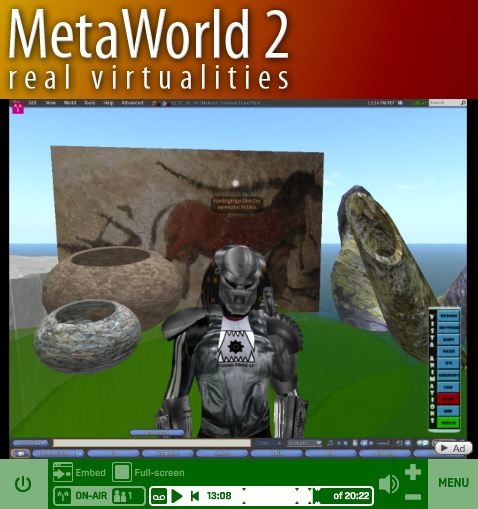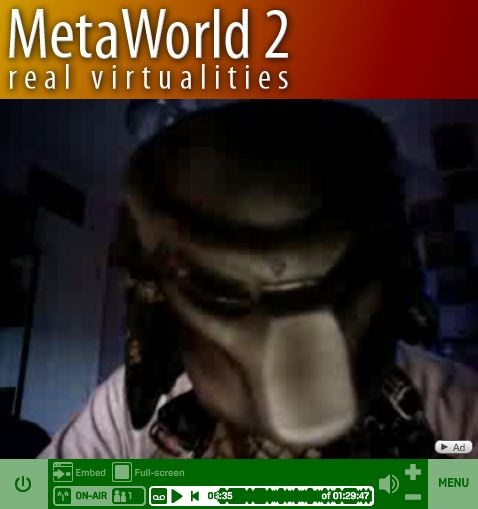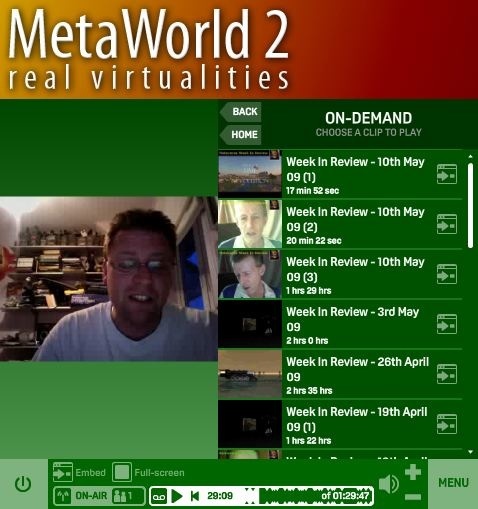People sometimes moan that the user contributed web is full of rubbish, but whilst that may be true it does mean that talent shines out more. I have been enjoying the occasional watch of Mystery Guitar Man’s work on youtube.
It is deceptively difficult to create edits like this. I love the use of annotations at the end too.
Many of us have the equipment and software to create great video and music now. So the fact there is an open and free distribution channel (i.e. the web not just YouTube) is fantastic.
If you want to, and if you have the talent you can just get on with it 🙂
proof
Its not all Android and iphone AR you know?
To keep the rolling theme of Augmented Reality going and highlight interesting applications Ron Edwards from Ambient Performance has recently posted this tagged AR demonstration but running on a Nokia N95.
So that means there have been good AR demonstrations live on Android, Iphone, S60 and a quick youtube shows some on windows mobile too. 😉
There is a definite technology way rolling based on the mass adoption of relatively powerful smartphones (probably powered by the user friendly nature of the Apple Iphone) with cameras and internet connectivity, combined with opensource development components to help build on these too.
I would say watch this space, but the space will get filled with something rendered in realtime!
Look at that for product placement
I have obviously been out and about making the most of Feeding Edge as my new company. It is something some people have asked me why I did not just go and get another job elsewhere. Well its this sort of placement such as Metanomics gave me, that shows why I had to try and make myself available through Feeding Edge to the industry to make things happen. A regular IT job would not have had this sort of positioning and influence. Many of my fellow metaverse evangelists and experts have been hung out to dry in some cases, or still battling in various companies to deal with intransigence of those who do not get, or fear, the changes social media and virtual worlds will bring about to their status quo (Cue Seth Godin again!). In a new and growing industry though we are still not at the point of too many companies knowing they need us to help them make the transition. However we all know that they will. So we have to keep going to make the right things happen in the right places.
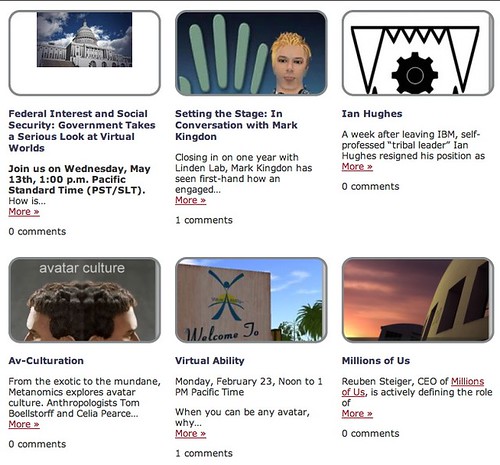
When your brand new company logo and name appears to the right of one of the most influential companies in the virtual world industry Linden Lab & Second Life and their CEO Mark Kingdon, and just above Millions Of Us and Reuben Steiger (The original metaverse evangelist formerly of Linden Lab) it does make you think you are doing the right thing 🙂
This really speaks to the power of us as individuals. A recent article on my wife’s financial management magazine (aimed at management accountants) spoke of companies having to understand that we now have pebbles and boulder organizations. A collection of pebbles, small fast moving easily collected and nimble can easily out maneuver a large corporate boulder. When those companies that are large boulders start to utilize the fact that they can be regarded as collections of pebbles rather than one huge mass then they will be able to survive and operate and thrive.
Of course if your are incentivized through money,power or ego to sit astride a large boulder the notion of smaller networked groups of pebbles will be threatening and scary. I do think though it is a case of adapt or die. Can large organizations deal with that? I think they can, I think it will happen over time but will need people who are willing to lead to make the changes happen quicker. Hey! that’s what I do for people 🙂
Tribes – Pay attention please
If you have not had a chance to read Seth Godin’s tribes, watch this video instead. If you have read Seth Godin’s Tribes, watch this video from TED anyway.
For me he gave a name and a validation to what I think I was doing with my virtual world movement in the corporate world. I started way back before this book was described. However a desire to change things when people suggested “its always been done this way, we dont like it but what can you do?” is a powerful driver. Now that everywhere and everyone is local to us and we are able to gather and share there is no excuse to not make tribes work.
This should also be a waker up call for people who feel at odds with anything they have to operate with or within. Godin has managed to show that whilst we may consider this a revolution, it is in fact taking us back to basics, back to our human needs rather than us being a slave to systems of our own creation.
If you are in marketing, or locked into corporate ways of doing things or in any regimented organization take note and adapt.
As I always point out if anyone needs to know the story of how this all happened to me and my former collegues, the rise of eightbar and adoption of virtual worlds in the enterprise I am more than happy to come and share that with you. (It’s an ever evolving story!)
Props to Rich White whose blog attracted my attention to this video, via twitter 🙂
Props also to Ian Smith, he introduced me to Seth Godin’s work and in particular Tribes
Hijacking the Metaverse Week In Review
Last night Malburns kindly invited me on to the Mogulus powered Metaverse week in review show. We had been talking about various things at the Apply Serious Games conference and he asked me if I would come and appear, chat and also talk a bit about Feeding Edge.
I had a Mogulus account signed up and Mal invited me to be part of the channel, i.e. the ability to deliver video and audio content into the channel. I have to say I had not experiemented before the show other than to try the windows Procaster plugin application that lets you stream your Second Life (or any other window in as the video source). So as the show was going live, and I had assumed we were all meeting in world I hit the publish button on my machine. I had not realized that the default settings were to instantly publish to the channel rather than just enter the studio application ready to be cued in live. So SL epredator appeared and cut Mal off. (oops)
Once I got introduced in and tried the broadcast it all went OK (apart from knowing the sort of delay we were dealing with). Once I had finished my talking I cut the channel publication, but that seemed to cut off the end of what I was saying as I should have just left it running and let Producer Mal cue himself up.
So then it seemed a good idea for my next talking bit to go to webcam and live me. So I switched to the Mac, and sparked up the web studio application. (I failed to notice the audio monitor on/off button). On going live I generated a massive feedback loop as the MBP mic and speakers did not noise cancel. However that resolved and seeing the toggle (as well as everyone screaming at me in chat) we were soon back to normal.
I really enjoyed the show for the live nature of it, but I particularly enjoyed hearing what Jenn Hienrichs has to say about here plans and the excellent story approach she is taking to “SL Things to Do” a group of travellers and explores that I remember well form the early days visiting Wimbledon SL in 2007.
Anyway the various parts of all this (as it got archived in 3 parts due to my interference can be found here On demand Live Shows, Week in review 10th May. (Update 15th Sep 2021) The found here link no longer works as Mogulus went a while ago)
Anyway, thanks for having me on the show, and thanks for letting me break a few things in order to learn 🙂
Six Degrees is just a game? Proof of serendipity?
This week the BBC aired a programme on the science of Network Analysis. Since the programme I have talked to lots of people and we have all said the same thing. Yes we knew all about the Six Degrees of Kevin Bacon game. We all live and work in social media (a self selecting bunch of people I talk to of course), so we all understand the power of the connected hub and the ability to link people and ideas and spread the word. We all knew the obvious statements that disease spreads through contact hubs where people have more direct contact with others. We all knew that travel broadens the mind and also the dispersal of families and companies at a global level means the world is smaller.
Its all obvious. That does not mean that it is wrong of course.
The programme sought to show the science and maths involved in the description of the various types of network theory. It also did an experiment involving random people in far flung part of the world having to find a people to help get a package to someone they did not know. i.e. pass it on and see how many steps it really took.
That worked very well too.
The piece of the puzzle that is the most thought provoking is the places these clumped networks of relationships, hubs of influence and transmitters exists. Social Networks, The Web, Flu spreading are the classic obvious ones. However in studying this scientists have found the patterns and principles apply at all sorts of meta levels.
One that I thought they might have explicitly pointed out, but may have just been subtle and clever scripting was the fact that the hsitory of the network theory development was itself a network of hubs and connectors. Someone happened to see an article by someone else etc.
The striking one was that scientists mapped all diseases and their relationships to one another, each has a relationship to another, and some common hubs act as a link between many disparate ilnesses.
Just consider that, every illness we can suffer is just six degrees of separation or less from another via their structure and our genes.
If we look at networks of networks the same patterns will apply. The patterns continue in a repeating fractal nature at any level you care to consider, from brain cells to the eco system, financial systems to planetary systems.
Why is this relevant?
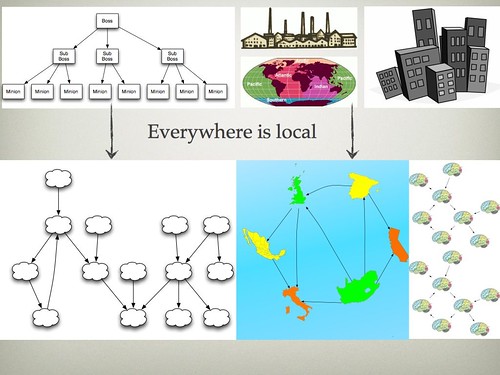
We have through various pieces of technology, from email and the telephone to virtual worlds provided a way to make these connections even faster to use the network effect to transmit ideas to one another. It surely makes sense to be aware of the nature of the structure of networks and hubs that helps adoption of an idea, a technology or a movement.
In trying to help people come to terms with a change you have to deal with the hubs, or reduce your path to the hubs. Convincing people on the periphery of a network has to be done, but the aim is to get to the fast connector, the fast influencer.
It would seem the fast influencer and meta network that many people look to is money. The conversations on technology adoption and its usage tends to be based on objections or otherwise of ROI. However, money is a network in its own right. There are hubs, people with more access to more money that need to be influenced. Money though is not the only network here. As we often say the virtual world and social media is not about the technology it is about people. People themselves are collections of networks, from those they belong to socially, to the collection of neurons that form the brain.
It struck me that the best way to get people to adopt something is not to appeal to just one of their networks. instead to appeal to the network of networks. Just as each disease is shown to be part of its own network of diseases and the cure for one major one might be found by focussing on the nearest apparently unrelated disease on the surface, then adoption curves and getting people to where we think they need to be may be best done via another route than their major network.
I then realized that in some ways I had been explaining this and doing this all along. I often help people who want to know how you convinces crowds of people to follow an idea. The key is to make is personal to each individual. To now dive straight at their primary concern (in business this is money/ROI etc). Instead you appeal to another part of their own network, rather than the network they are part of.
Finding a long lost friend of relative, discovering someone with the same passion for the same hobby, being inspired by an idea, being able to show off, even taking a moment to think of others. All these when applied to the person you are trying to help and convince will work so much better than the £ or $ signs in most cases. Once they have experienced even in the smallest amount a change to their internal biological personal network then they will be open to consider the influence they may have on the networks they are in.
Another example was clearly how the use of Second Life at Wimbledon, via IBM made people consider the potential options of virtual worlds. To me the link made sense, the network and flow was clear. However looking back it is even more obvious in the context of peoples internal influence networks. Wimbledon is an emotive hub. Sport, whilst a business to some is an emotive experience, seldom about the prize money or company share price, but about competition. Attaching such an emotive hub to the personal experiences that we have in virtual worlds made sense. The second hub, that of a solid Blue Chip IT business clearly also appealed to a different network of business. Hence Second Life, Wimbledon and IBM became three super hubs joining multiple networks of people, ideas, emotions and motivators.
I often point out how we have to rely on serendipity. I think now that serendipity really is the collision of multiple types of network at a point in time. Seemingly unrelated things occur and form a pattern we cannot quite discern, but we feel that something is right.
The trick is to feel these networks at all their various levels, not just social and try and weave them and make them collide in a positive way.
So next time you are focussed on one goal, one target, one idea just for a second considered the multitude of networks that that may for part of. Look at those may just get you to that goal quicker, and open up a whole new set of others.
To quote Snowcrash (again) “Is it a virus, a drug or a religion…. what’s the difference?”
Worth paying attention to these books
I have written about some of these things elsewhere but as this is turning over a new digital leaf I thought it worth mentioning some key things that I think are worth paying attention to when you are trying to persuade people of the benefits of the current wave of emerging technology.
- Seth Godin’s book Tribes
which for me is more of a history book as it came after our tribe had already got going . It shows the sort of attitude and actions across the available media to get a massive adoption of an idea and of a movement, which indicates that if others take note of his style and approach, if they like his angle on things, then they can be successful too.
- Don Tapscott’s latest Grown Up Digital: How the Net Generation is Changing Your World
which is really for those who need to see the statistics about the wealth of engagement across all forms of social media and whilst may not be able to engage yet, will need to see what the workforce will expect in the very near future.
- Sandy Carter’s The New Language of Marketing 2.0: How to Use ANGELS to Energize Your Market: Screaming ANGEL
which is a book about the marketing steps that can be taken and starts to explain how engagement works, with case studies (including what we did at Wimbledon with Second Life).
Each of these three books offer a convincing set of approaches for certain types of people. Godin is more evangelical, Tapscott scientific analysis, Carter offers practical steps for business.
I have of course alluded to my own book, having not written a whole book before, but instead stacks of individual presentations and ideas I am working up the thread of my story. Trying to in some way cross the approach of these three books, without repeating too much of course. The history and the challenges faced as an intrapreneur, and the ways to bypass those obstacles that really should not be there will form the main arc. I can only really be personal about these things as it is when I feel things happen I can articulate them. Facts can work for some people, but when they have their mind set against something, or are not in a receptive mood for change it is not clear facts that alter those states. Here I give a nod to all my fellow metaverse and social media evangelist friends, how often have we said, armed with a fact or two “but it’s obvious!”
It is really the fun in all this, finding what it is that makes people so anti an idea, or so supportive of it and blending the two in a way everyone is supportive rather than resolving to a balanced zero!
It really is that simple, virtual world whiteboards and diagrams
As a first bite on technology so you dont have too I thought this subject would be a good place to start.
A common theme I often come across is one of the need to deal with certain real world applications in a virtual world. As with all things related to mirror worlds the assumption often has to start at a replication of exactly the way we currently do something. In some ways it could be considered a challenge to virtual worlds that they are made as effortless as a blackboard and chalk are in todays class rooms. The pencil and a piece of paper has done us proud over many years. There is a place for a simple pen outline or diagram, a chalk and talk to a sports team, a hey guys I have a great idea look at this etc. Those work really well in real rooms, where people just grab whatever they have to hand, adjust to their surroundings and draw and share. At the moment virtual worlds do make that quite tricky. Intricate details take time. We have pens and touch tablets, screen sharing etc and it is of course possible to inject that into many virtual worlds in various ways.
However, I want people to go back and think this over. Even with the metaverse technologies we have today we already have very effective and simple tools often built in, that at almost no cost can be used to get a point across. More than one person present at a place in a virtual environment able to see the ideas form and mental placeholders moved around them as the person explaining the idea manipulates the environment.
I produced this video, a live one take event. The aim to show that if I wanted to explain something, in this case it could even be a sports play of some sort, I could with no frills, no fancy touches show my ideas. The example shows using Second Life or Opensim (though anywhere you can rez anything this would apply) creating objects, moving them around, assigning meaning through colour and position and manipulating the environment live can be done simply and to great effect.
The idea is to understand these basics and be then able to visualize the potential. If with a little more effort these movements are recorded and replayed back, interchange with other services, if the blocks are replaced with more detailed meaningful models, if simpler interfaces make moving the pieces even easier, if weight and friction and physics are used they all start to enhance the basic feature. One that is an environment that is adjustable and not constrained by the limits of a whiteboard, or piece of paper or laptop presentation.
The takeaway from this is that there are many ways already to use a metaverse platform to exchange ideas. It can be as simple as this. In a given situation this may be enough to sketch a solution. This basic experience can be made much more visually stimulating, if it needs it, but it required no buildings, places, presences, branded experiences to get this across in 2 minutes. Get some people together, just try it and see if it works.
****UPDATE In order to understand and actually visualize how these things can work when directed at a particular sport and with gaming console technology you can see what happens here in a fan video for Madden 09, using the tools available to describe American Football offence tactics.

